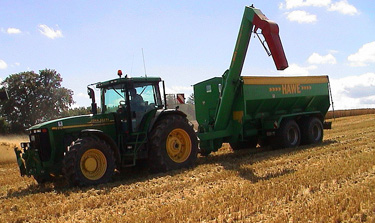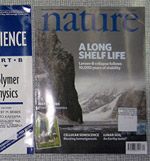Study links agricultural intensity with fish decline in streams
 Agriculture,
Agriculture,  Fish,
Fish,  Freshwater
Freshwater  Ueberladewagen (German). Image credit, Hinrich.A recent study in the journal Fisheries Management and Ecology links declines in riverine fish communities in Finland with intensive agriculture and its impacts on water quality.
Ueberladewagen (German). Image credit, Hinrich.A recent study in the journal Fisheries Management and Ecology links declines in riverine fish communities in Finland with intensive agriculture and its impacts on water quality.
Researchers Tappio Sutela and Teppo Vehanen surveyed fish from 27 medium-sized rivers in the northern part of the country. They also calculated a fish-based index developed for the evaluation of the ecological integrity of rivers.
The researchers then correlated their data with a measurement of agricultural intensity in the surrounding countryside and several indicators of water quality including total phosphorus, pH, total solids, and oxygen saturation.
The study found that at greater levels of agricultural intensification, water quality was significantly worse (particularly for total phosphorus, suspended solids and chemical oxygen demand), the composition of the fish community changed, and the fish-based index of ecological intergrity scored significantly lower.
Agriculturally intensive areas saw increases in species generally considered tolerant of human disturbance (pike, roach, ruffe and perch). Meanwhile these same areas saw a decrease in fish typically considered intolerant of anthropogenic activities (bullhead, alpine bullhead, minnow, and grayling).
The researchers explain that negative impacts to fish can occur when increased sedimentation from agriculture impairs the condition of spawning gravels and reduces survival of fish eggs and embryos. Sedimentation can also reduce availability of benthic food sources for fish.
While past research in the United States has found a similar relationship between agricultural intensity, water quality, and fish communities, fewer studies have focused on the linkages in Europe. Despite the findings, the authors caution that the study only found correlation, which does not necessarily mean causation.
For example, they noted that a latitudinal bias exists in the intensity of agriculture in the area. Also, the results were counterintuitive for a couple of species. For example, the stone loach increased under intensive agriculture even though it is generally considered intolerant of human disturbance.
Nevertheless, the findings are a cause of concern. The authors advise that maintaining woody riparian areas along streams may help prevents some of the negative effects of intensive agricultural on fish assemblages.
--Reviewed by Rob Goldstein
SUTELA, T., & VEHANEN, T. (2009). Responses of fluvial fish assemblages to agriculture within the boreal zone Fisheries Management and Ecology DOI: 10.1111/j.1365-2400.2009.00711.x




Reader Comments